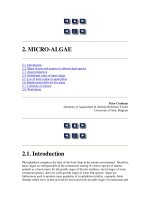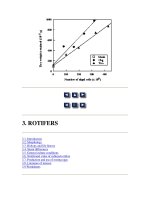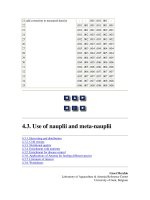Tài liệu Chapter 8: Potential Energy and Conservation of Energy doc
Bạn đang xem bản rút gọn của tài liệu. Xem và tải ngay bản đầy đủ của tài liệu tại đây (244.43 KB, 16 trang )
Chapter 8
Potential Energy and Conservation of Energy
In this chapter we will introduce the following concepts:
Potential Energy
Conservative and non-conservative forces
Mechanical Energy Conservation
of Mechanical Energy
The conservation of energy theorem will be used to solve a variety of
problems
As was done in Chapter 7 we use scalars such as work ,kinetic energy,
and mechanical energy rather than vectors. Therefore the approach is
mathematically simpler.
(8-1)
A
B g
v
o
h
v
o
Work and Potential Energy:
Consider the tomato of mass m shown in the figure. The
tomato is taken together with the earth as the system we
wish to study. The tomato is thrown upwards with initial
speed v
o
at point A. Under the action of the gravitational
force it slows down and stops completely at point B. Then
the tomato falls back and by the time it reaches point A its
speed has reached the original value v
o
.
Below we analyze in detail what happens to the tomato-earth system.
During the trip from A to B the gravitational force F
g
does negative work
W
1
= -mgh. Energy is transferred by F
g
from the kinetic energy of the tomato
to the gravitational potential energy U of the tomato-earth system.
During the trip from B to A the transfer is reversed. The work W
2
done by
F
g
is positive ( W
2
= mgh ). The gravitational force transfers energy from the
gravitational potential energy U of the tomato-earth system to the kinetic
energy of the tomato. The change in the potential energy U is defined as:
U W
∆ = −
(8-2)
A
A
B
B
k
m
Consider the mass m attached to a spring of spring
constant k as shown in the figure. The mass is taken
together with the spring as the system we wish to study.
The mass is given an initial speed v
o
at point A. Under the
action of the spring force it slows down and stops
completely at point B which corresponds to a spring
compression x. Then the mass reverses the direction of its
motion and by the time it reaches point A its speed has
reached the original value v
o
.
As in the previous example we analyze in detail what happens to the mass-
spring system . During the trip from A to B the spring force F
s
does negative
work W
1
= -kx
2
/2 . Energy is transferred by F
s
from the kinetic energy of the
mass to the potential energy U of the mass-spring system.
During the trip from B to A the transfer is reversed. The work W
2
done by F
s
is positive ( W
2
= kx
2
/2 ). The spring force transfers energy from the
potential energy U of the mass-spring system to the kinetic energy of the
mass. The change in the potential energy U is defined as:
U W
∆ = −
(8-3)
m
m
A B
v
o
f
k
f
k
x
d
Conservative and non-conservative forces.
The gravitational force as the spring force are
called “conservative” because the can transfer
energy from the kinetic energy of part of the
system to potential energy and vice versa.
Frictional and drag forces on the other hand are called “non-conservative” for
reasons that are explained below.
Consider a system that consists of a block of mass m and the floor on which it
rests. The block starts to move on a horizontal floor with initial speed v
o
at
point A. The coefficient of kinetic friction between the floor and the block is μ
k
.
The block will slow down by the kinetic friction f
k
and will stop at point B
after it has traveled a distance d. During the trip from point A to point B the
frictional force has done work W
f
= - μ
k
mgd. The frictional force transfers
energy from the kinetic energy of the block to a type of energy called thermal
energy. This energy transfer cannot be reversed. Thermal energy cannot be
transferred back to kinetic energy of the block by the kinetic friction. This is
the hallmark of non-conservative forces.
(8-4)
Path Independence of Conservative Forces
In this section we will give a test that will help us
decide whether a force is conservative or non-
conservative.
A force is conservative if the net work done on a particle during a round trip is
always equal to zero (see fig.b).
Such a round trip along a closed path is shown in fig.b. In the examples of the
tomato-earth and mass-spring system W
net
= W
ab,1
+ W
ba,2
= 0
We shall prove that if a force is conservative then the work done on a particle
between two points a and b does not depend on the path.
From fig. b we have: W
net
= W
ab,1
+ W
ba,2
= 0 → W
ab,1
= - W
ba,2
(eqs.1)
From fig.a we have:
W
ab,2
= - W
ba,2
(eqs.2)
If we compare eqs.1 and eqs.2
we get:
0
net
W =
,1 ,2ab ab
W W=
(8-5)
O
x
.
.
.
x
i
x
x
f
F(x)
In this section we will discuss a method that can
be used to determine the difference in potential
energy of a conservative f
Determining Potential Energy
orce between
points
Values
and on
:
t
f i
U F
x x
∆
he -axis if we know ( )x F x
A conservative force moves an object along the -axis from an initial point
to a final point . The work that the force does on the object is given by :
( ) The corresponding ch
f
i
i
f
x
x
F x x
x W F
W F x dx=
∫
ange in potential energy was defined as:
Therefore the expression for becomes:
U
U W U
∆
∆ = − ∆
( )
f
i
x
x
U F x dx∆ = −
∫
(8-6)









